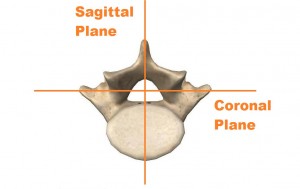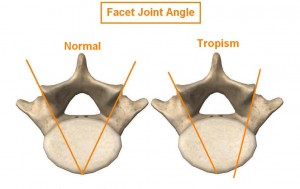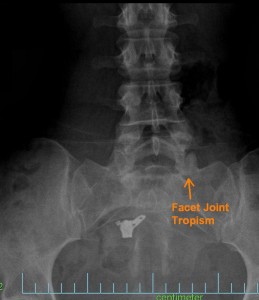Facet Tropism
Tropism is developmental abnormality of the spine.
If you have reoccurring pain on one side of your lower back when you bend or twist in certain motions, you may have facet tropism. This is a developmental abnormality of the small joints of the lower lumbar spine. A child can be born with a slight alignment issue to the spinal joints, and the problem persists into adulthood. Surgery is not generally a good option for most people. Conservative measures (like chiropractic care) can greatly reduce the frequency, duration, and intensity of pain associated with facet tropism.
Spinal joints have a direction.
In the normal lumbar spine, the facet joints have a predictable orientation. The plane of the paired facets should match up and allow for smooth, even motion. At the bottom of the lumbar spine, the facet is optimized for bending forward as well and sideways bending. The two joints have the same orientation. Typically, the alignment of the facet is about half-way between the coronal plane and the sagittal plane of the body. Having the plane angles equal and mirrored reduces stress to the joint by spreading weight-bearing forces evenly.
Tropism is improper alignment of the joint.
If the facet joints do not have proper orientation, stresses are applied to the structures. These joint stresses can cause sharp pain as well as promoting inflammation. When inflammation is allowed to persist, the joint surfaces erode. This leads to arthritis of the facet joint. It’s just like a car-tire out of alignment causing a slow, steady wear on the tire.
Tropism can occur when the facet is aligned in either the coronal or sagittal plane. I have seen cases when one facet is coronal and the other is sagittal. Those patients have considerable pain since both sides are misaligned.
Patients are often unaware of the condition.
Frequently, patients are unaware of the alignment tropism until they reach adulthood. As a young person, the bones are more pliable and can tolerate the mechanical stresses better. As we age, the bones and joint surfaces become less tolerant.
A chiropractor can identify a tropism on x-ray. X-rays are fairly inexpensive and provide a tremendous amount of information for the small amount of resources invested. The x-ray below is one that I took a few months ago.
Treatment involves management of the pain and movement.
Surgery is not a realistic option for most people. The risk/benefit ratio does not pan out. Most people benefit by conservative measures involving inflammation reduction and improved joint biomechanics.
Because this is a life-long issue, pain medications are generally a bad idea. Pain medications are not to be used long-term.






